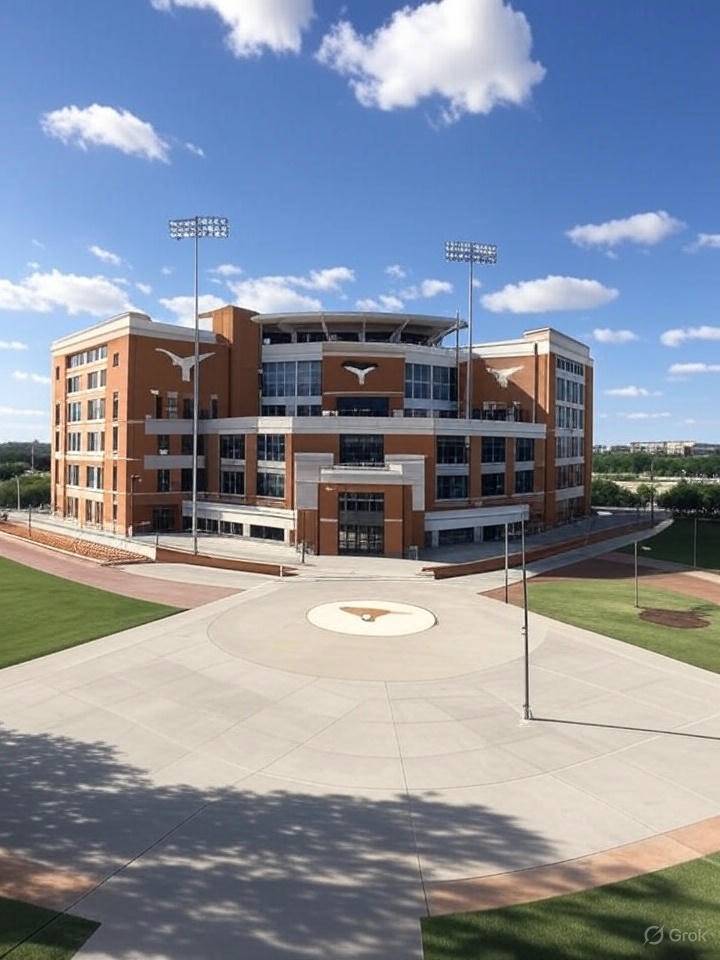The University of Texas Longhorns have disclosed ambitious plans to drastically renovate their softball program’s home, Red and Charline McCombs Field, making it into one of the nation’s finest softball grounds; work on the pioneering endeavor will begin in 2026.
The University of Texas Longhorns have disclosed ambitious plans to drastically renovate their softball program’s home, Red and Charline McCombs Field, making it into one of the nation’s finest softball grounds; work on the pioneering endeavor will begin in 2026. This monumental decision, reflecting the school’s deep commitment to its softball program and women’s athletics as a whole, marks a new chapter in the evolution of Longhorns softball and underscores the ever-growing prominence of the sport both in Austin and nationwide. The announcement was met with great enthusiasm from fans, players, and alumni alike, as many see the move as long overdue and a clear statement that Texas is serious about building a championship-caliber program with facilities that match its ambitions.
The upgraded Red and Charline McCombs Field will no longer be just a modest venue nestled within the university campus; rather, it will become a state-of-the-art complex designed to rival the best in college softball. The plans include expanded seating capacity, improved sightlines, modernized locker rooms, cutting-edge training and recovery areas, enhanced media facilities, and updated fan amenities, all crafted with both functionality and fan experience in mind. These changes are not just cosmetic—they’re a signal that Texas intends to become a national powerhouse not only in terms of talent and coaching but also in terms of the environment it provides for development and performance.
For years, critics have pointed to McCombs Field as a facility that, while serviceable, lagged behind the more modern stadiums at other elite softball programs such as Oklahoma, Alabama, and Florida. The Longhorns’ consistent success on the diamond in spite of these limitations has been a testament to the program’s strength and resilience. Still, there has long been a sense that if Texas truly wanted to reach its full potential and contend for national championships regularly, an investment in its infrastructure was essential. Now, with this renovation project, the university is making a bold statement that it will no longer settle for being merely competitive—it wants to dominate.
The significance of these upgrades goes beyond brick and mortar. They symbolize Texas’s intent to be at the forefront of the changing landscape of collegiate athletics, where facilities play a crucial role in recruiting, retaining, and developing elite athletes. Prospective student-athletes now view state-of-the-art facilities as a baseline expectation, not a luxury, and by meeting this demand, Texas positions itself as a top destination for the nation’s best softball players. The renovated McCombs Field will allow head coach Mike White and his staff to more effectively recruit top-tier talent from across the country, giving Texas a crucial edge in the ultra-competitive world of NCAA softball.
In addition to player development and recruitment, the fan experience is set to be revolutionized. The plans include a significant increase in seating capacity, ensuring that more fans can attend games and contribute to what Texas hopes will become one of the most intimidating home-field environments in the sport. Enhanced concession areas, restrooms, and shaded seating will elevate the comfort and convenience for spectators, making a trip to McCombs Field a more enjoyable experience for families and diehard fans alike. These improvements align with a broader trend across college sports, where schools are recognizing that fan engagement plays a vital role in the success of athletic programs, both in terms of atmosphere and financial sustainability.
Another central component of the renovation is the incorporation of advanced technology throughout the complex. From high-definition video boards and improved broadcast capabilities to data-driven performance analysis tools and upgraded sound systems, the new McCombs Field will be a hub of innovation. These technological enhancements are not just for show—they’ll play a pivotal role in how the team prepares, analyzes, and improves, bringing a level of sophistication that mirrors what is seen at the professional level. This alignment with pro-level standards is intentional, as it sends a powerful message to recruits that Texas is preparing its athletes for success not only in college but potentially beyond.
The timing of the renovations is also strategic. With softball continuing to grow in popularity across the United States and participation rates climbing at the youth level, there’s a broader movement underway to invest in the sport at the collegiate level. Texas, always eager to be at the forefront of emerging trends, is wisely capitalizing on this momentum. The visibility and prestige of the Women’s College World Series have never been higher, and by committing resources now, Texas is ensuring that it won’t be left behind as the sport ascends to new heights. Instead, it aims to be one of the programs setting the pace.
University officials have noted that the renovation project will be funded through a combination of private donations and athletic department revenue, with no increase in student fees. The philanthropic support for the project has reportedly been strong, reflecting a deep reservoir of goodwill and enthusiasm for the program among alumni and supporters. Donors see the project not only as a chance to support Longhorns athletics but also as a meaningful way to advance gender equity in sports by providing female athletes with facilities that reflect their importance and achievements. In an era where schools are being called to back up their stated commitments to equity with real investment, this project stands out as a model for others to follow.
Longtime supporters of Texas softball have watched the program grow steadily over the past two decades, transitioning from a regional power to a national contender. The arrival of Coach Mike White brought renewed energy and higher expectations, and he has delivered with deep postseason runs and a team that consistently competes at the highest level. However, it has been clear to many that for Texas to take the next step—especially in the ultra-competitive SEC, which the school is set to join—it would need facilities that match the caliber of the program. These renovations are a direct response to that need and reflect a broader institutional strategy to hit the ground running in what is widely regarded as the best softball conference in the country.
Players past and present have reacted positively to the news, with many expressing excitement about what the future holds. Alumni have shared their pride in seeing the program receive the support it has long deserved, while current players are thrilled at the prospect of training and competing in a facility that matches their ambitions. Beyond the emotional boost, the new complex is expected to have a tangible impact on player development, recovery, and performance, thanks to the inclusion of amenities like hydrotherapy areas, nutritional support spaces, and expanded practice fields. These elements reflect a holistic understanding of athlete needs and a commitment to their well-being on and off the field.
The local community also stands to benefit. With a larger, more accessible stadium, the hope is that Texas softball can attract even bigger crowds and become an even more integral part of the Austin sports landscape. Youth softball teams, in particular, will be able to look up to the Longhorns as role models and, thanks to the upgraded venue, may have more opportunities to attend games, participate in camps, and interact with players and coaches. The ripple effects of this kind of engagement are significant—it helps grow the game at the grassroots level and fosters a culture of support that can sustain the program for generations to come.
Moreover, the design and construction of the new McCombs Field are being undertaken with sustainability in mind. University officials have indicated that the project will incorporate green building practices, energy-efficient systems, and sustainable materials wherever possible. This commitment to environmental responsibility aligns with broader university goals and represents an effort to ensure that the new facility is not just world-class in terms of athletics but also in terms of stewardship and long-term impact. In this way, the project is about more than just softball—it’s about building something that the entire university community can take pride in.
The road ahead is one filled with anticipation, but also with challenges. Construction of a major sports facility in a busy university setting requires careful planning and coordination, and university leaders have emphasized that they will work closely with stakeholders to minimize disruptions and ensure that the project stays on track. Timelines will be closely monitored, and the university will remain transparent with updates throughout the process. While some inconveniences are inevitable, the long-term payoff promises to be immense—a facility that elevates not just Texas softball, but the entire athletics program.
As 2026 draws closer, the excitement around Red and Charline McCombs Field will only continue to build. For Texas fans, players, coaches, and supporters, this project represents more than a construction timeline—it represents a vision. A vision of excellence, of competitiveness, of pride. It is a vision that sees Texas softball not as a side note, but as a centerpiece. One that envisions the burnt orange flying high not just at conference tournaments, but at the Women’s College World Series, competing for national titles in a home stadium worthy of champions. This renovation will serve as a foundation for that vision, laying the groundwork for decades of success to come.
In the end, the transformation of Red and Charline McCombs Field is about more than a softball stadium. It is about recognizing the importance of investing in women’s sports, about creating spaces where athletes can thrive, and about ensuring that the University of Texas remains at the cutting edge of college athletics. As the bulldozers arrive and the blueprints come to life, a new era will begin in Austin—one built on ambition, driven by excellence, and defined by the unmistakable spirit of the Longhorns.
, making it into one of the nation’s finest softball grounds; work on the pioneering endeavor will begin in 2026. This monumental decision, reflecting the school’s deep commitment to its softball program and women’s athletics as a whole, marks a new chapter in the evolution of Longhorns softball and underscores the ever-growing prominence of the sport both in Austin and nationwide. The announcement was met with great enthusiasm from fans, players, and alumni alike, as many see the move as long overdue and a clear statement that Texas is serious about building a championship-caliber program with facilities that match its ambitions.
The upgraded Red and Charline McCombs Field will no longer be just a modest venue nestled within the university campus; rather, it will become a state-of-the-art complex designed to rival the best in college softball. The plans include expanded seating capacity, improved sightlines, modernized locker rooms, cutting-edge training and recovery areas, enhanced media facilities, and updated fan amenities, all crafted with both functionality and fan experience in mind. These changes are not just cosmetic—they’re a signal that Texas intends to become a national powerhouse not only in terms of talent and coaching but also in terms of the environment it provides for development and performance.
For years, critics have pointed to McCombs Field as a facility that, while serviceable, lagged behind the more modern stadiums at other elite softball programs such as Oklahoma, Alabama, and Florida. The Longhorns’ consistent success on the diamond in spite of these limitations has been a testament to the program’s strength and resilience. Still, there has long been a sense that if Texas truly wanted to reach its full potential and contend for national championships regularly, an investment in its infrastructure was essential. Now, with this renovation project, the university is making a bold statement that it will no longer settle for being merely competitive—it wants to dominate.
The significance of these upgrades goes beyond brick and mortar. They symbolize Texas’s intent to be at the forefront of the changing landscape of collegiate athletics, where facilities play a crucial role in recruiting, retaining, and developing elite athletes. Prospective student-athletes now view state-of-the-art facilities as a baseline expectation, not a luxury, and by meeting this demand, Texas positions itself as a top destination for the nation’s best softball players. The renovated McCombs Field will allow head coach Mike White and his staff to more effectively recruit top-tier talent from across the country, giving Texas a crucial edge in the ultra-competitive world of NCAA softball.
In addition to player development and recruitment, the fan experience is set to be revolutionized. The plans include a significant increase in seating capacity, ensuring that more fans can attend games and contribute to what Texas hopes will become one of the most intimidating home-field environments in the sport. Enhanced concession areas, restrooms, and shaded seating will elevate the comfort and convenience for spectators, making a trip to McCombs Field a more enjoyable experience for families and diehard fans alike. These improvements align with a broader trend across college sports, where schools are recognizing that fan engagement plays a vital role in the success of athletic programs, both in terms of atmosphere and financial sustainability.
Another central component of the renovation is the incorporation of advanced technology throughout the complex. From high-definition video boards and improved broadcast capabilities to data-driven performance analysis tools and upgraded sound systems, the new McCombs Field will be a hub of innovation. These technological enhancements are not just for show—they’ll play a pivotal role in how the team prepares, analyzes, and improves, bringing a level of sophistication that mirrors what is seen at the professional level. This alignment with pro-level standards is intentional, as it sends a powerful message to recruits that Texas is preparing its athletes for success not only in college but potentially beyond.
The timing of the renovations is also strategic. With softball continuing to grow in popularity across the United States and participation rates climbing at the youth level, there’s a broader movement underway to invest in the sport at the collegiate level. Texas, always eager to be at the forefront of emerging trends, is wisely capitalizing on this momentum. The visibility and prestige of the Women’s College World Series have never been higher, and by committing resources now, Texas is ensuring that it won’t be left behind as the sport ascends to new heights. Instead, it aims to be one of the programs setting the pace.
University officials have noted that the renovation project will be funded through a combination of private donations and athletic department revenue, with no increase in student fees. The philanthropic support for the project has reportedly been strong, reflecting a deep reservoir of goodwill and enthusiasm for the program among alumni and supporters. Donors see the project not only as a chance to support Longhorns athletics but also as a meaningful way to advance gender equity in sports by providing female athletes with facilities that reflect their importance and achievements. In an era where schools are being called to back up their stated commitments to equity with real investment, this project stands out as a model for others to follow.
Longtime supporters of Texas softball have watched the program grow steadily over the past two decades, transitioning from a regional power to a national contender. The arrival of Coach Mike White brought renewed energy and higher expectations, and he has delivered with deep postseason runs and a team that consistently competes at the highest level. However, it has been clear to many that for Texas to take the next step—especially in the ultra-competitive SEC, which the school is set to join—it would need facilities that match the caliber of the program. These renovations are a direct response to that need and reflect a broader institutional strategy to hit the ground running in what is widely regarded as the best softball conference in the country.
Players past and present have reacted positively to the news, with many expressing excitement about what the future holds. Alumni have shared their pride in seeing the program receive the support it has long deserved, while current players are thrilled at the prospect of training and competing in a facility that matches their ambitions. Beyond the emotional boost, the new complex is expected to have a tangible impact on player development, recovery, and performance, thanks to the inclusion of amenities like hydrotherapy areas, nutritional support spaces, and expanded practice fields. These elements reflect a holistic understanding of athlete needs and a commitment to their well-being on and off the field.
The local community also stands to benefit. With a larger, more accessible stadium, the hope is that Texas softball can attract even bigger crowds and become an even more integral part of the Austin sports landscape. Youth softball teams, in particular, will be able to look up to the Longhorns as role models and, thanks to the upgraded venue, may have more opportunities to attend games, participate in camps, and interact with players and coaches. The ripple effects of this kind of engagement are significant—it helps grow the game at the grassroots level and fosters a culture of support that can sustain the program for generations to come.
Moreover, the design and construction of the new McCombs Field are being undertaken with sustainability in mind. University officials have indicated that the project will incorporate green building practices, energy-efficient systems, and sustainable materials wherever possible. This commitment to environmental responsibility aligns with broader university goals and represents an effort to ensure that the new facility is not just world-class in terms of athletics but also in terms of stewardship and long-term impact. In this way, the project is about more than just softball—it’s about building something that the entire university community can take pride in.
The road ahead is one filled with anticipation, but also with challenges. Construction of a major sports facility in a busy university setting requires careful planning and coordination, and university leaders have emphasized that they will work closely with stakeholders to minimize disruptions and ensure that the project stays on track. Timelines will be closely monitored, and the university will remain transparent with updates throughout the process. While some inconveniences are inevitable, the long-term payoff promises to be immense—a facility that elevates not just Texas softball, but the entire athletics program.
As 2026 draws closer, the excitement around Red and Charline McCombs Field will only continue to build. For Texas fans, players, coaches, and supporters, this project represents more than a construction timeline—it represents a vision. A vision of excellence, of competitiveness, of pride. It is a vision that sees Texas softball not as a side note, but as a centerpiece. One that envisions the burnt orange flying high not just at conference tournaments, but at the Women’s College World Series, competing for national titles in a home stadium worthy of champions. This renovation will serve as a foundation for that vision, laying the groundwork for decades of success to come.
In the end, the transformation of Red and Charline McCombs Field is about more than a softball stadium. It is about recognizing the importance of investing in women’s sports, about creating spaces where athletes can thrive, and about ensuring that the University of Texas remains at the cutting edge of college athletics. As the bulldozers arrive and the blueprints come to life, a new era will begin in Austin—one built on ambition, driven by excellence, and defined by the unmistakable spirit of the Longhorns.



